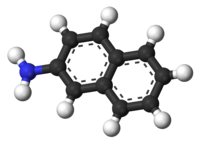| Revision as of 14:15, 25 October 2011 editCheMoBot (talk | contribs)Bots141,565 edits Updating {{chembox}} (changes to verified fields - added verified revid - updated 'DrugBank_Ref', 'UNII_Ref') per Chem/Drugbox validation (report errors or bugs)← Previous edit | Revision as of 09:23, 11 December 2011 edit undoZéroBot (talk | contribs)704,777 editsm r2.7.1) (Robot: Adding fi:2-naftyyliamiiniNext edit → | ||
| Line 67: | Line 67: | ||
| ] | ] | ||
| ] | ] | ||
| ] | |||
Revision as of 09:23, 11 December 2011

| |

| |
| Names | |
|---|---|
| IUPAC name 2-Aminonaphthalene | |
| Other names
2-Naphthylamine β-Naphthylamine | |
| Identifiers | |
| CAS Number | |
| 3D model (JSmol) | |
| ChEBI | |
| ChEMBL | |
| ChemSpider | |
| ECHA InfoCard | 100.001.892 |
| KEGG | |
| CompTox Dashboard (EPA) | |
InChI
| |
SMILES
| |
| Properties | |
| Chemical formula | C10H9N |
| Molar mass | 143.19 g/mol |
| Density | 1.061 g/cm |
| Melting point | 111-113 °C |
| Boiling point | 306 °C |
| Related compounds | |
| Except where otherwise noted, data are given for materials in their standard state (at 25 °C , 100 kPa).
| |
2-Naphthylamine is an aromatic amine. It is used to make azo dyes. It is a known human carcinogen and has largely been replaced by less toxic compounds. 2-Naphthylamine is prepared by heating 2-naphthol with ammonium zinc chloride to 200-210 °C; or in the form of its acetyl derivative by heating 2-naphthol with ammonium acetate to 270-280 °C. It forms odorless, colorless plates which melt at 111-112 °C. It gives no color with ferric chloride. When reduced by sodium in boiling amyl alcohol solution it forms alicyclic tetrahydro-3-naphthylamine, which has most of the properties of the aliphatic amines; it is strongly alkaline in reaction, has an ammoniacal odor and cannot be diazotized. On oxidation it yields ortho-carboxy-hydrocinnamic acid, HO2C•C6H4•CH2•CH2•CO2H. Numerous sulfonic acids derived from 2-naphthylamine are known. Of these, the δ-acid and Bronner's acid are of more value technically, since they combine with ortho-tetrazoditolyl to produce fine red dye-stuffs.
Role in disease
2-Naphthylamine is found in cigarette smoke and suspected to contribute to the development of bladder cancer.
It is activated in the liver but quickly deactivated by conjugation to glucuronic acid. In the bladder, glucuronidase re-activates it by deconjugation, which leads to the development of bladder cancer.
References
- Steinberg GD, Kim HL. Bladder Cancer. eMedicine.com. URL: http://www.emedicine.com/MED/topic2344.htm. Accessed on: May 9, 2007.